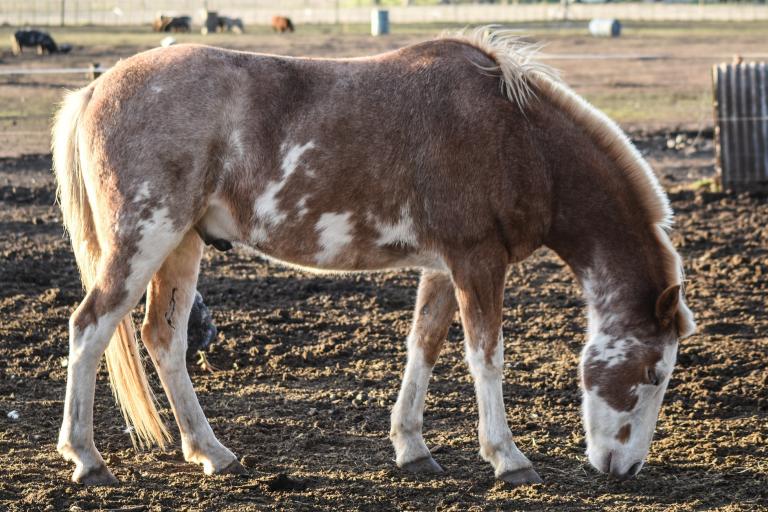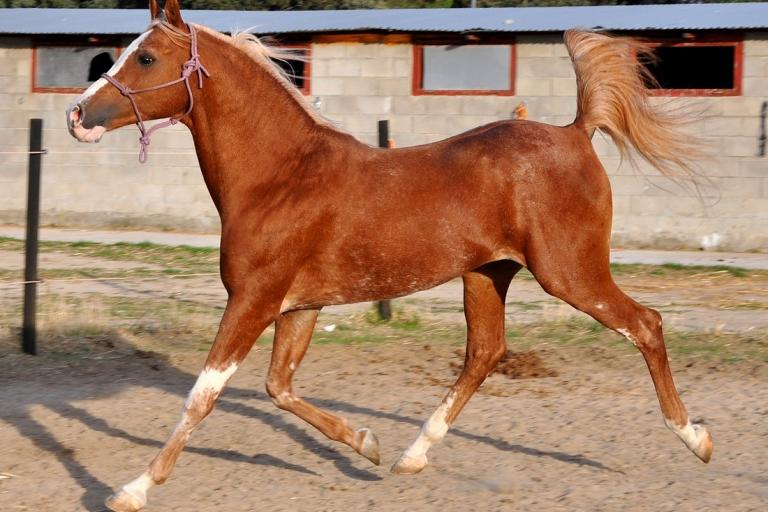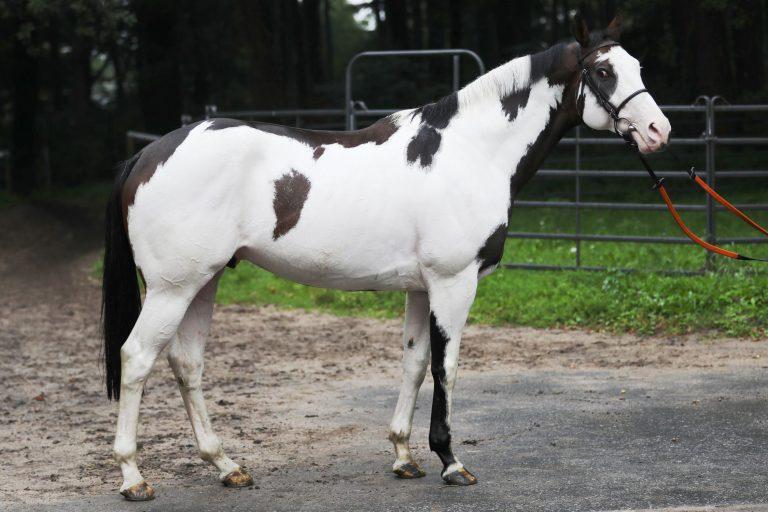White Spotting/Dominant White (Coat colour pattern Horse)
White Spotting (previously called 'Dominant White') is a general name given to a large number of white spotting patterns caused by mutations in the KIT gene. 30 'W' mutations are currently known. There is a large amount of variability in the amount/pattern of white caused by each of the mutations (W1-W30). Most 'W' mutations are breed or line specific, having originated in one specific horse.
Genetic Test: available in the Shop (W8, W19, W20, W21, W30)
Please ask us for more tests!
General Information
The White Spotting variants:
- White Spotting (previously called Dominant White) is a general name given to a large number of white spotting patterns caused by mutations in the KIT gene.
- Up to 30 'W' mutations are currently known. There is a large amount of variability in the amount/pattern of white caused by each of the mutations (W1-W30).
- Most 'W' mutations are breed or line specific, having originated in one specific horse. Some of these horses did not produce offspring, so while we make all 'W' tests available, it would be unlikely to show up in any other horse.
- Sabino (SB1) is also caused by a KIT mutation, but due to naming conventions in early publications, it was given a different official name, and is not considered to be one of the 'W' mutations. However, there are many 'W' mutations that have “sabino-like” patterns.
- It is uncommon for a horse to have two 'W' mutations, unless it is a specific 'W' mutation in combination with the W20 mutation.
- It is believed that most combinations of 'W' mutations are embryonic lethal, meaning the embryo does not develop and the mare simply cycles again as if she was not pregnant. This is different than the overo lethal white foal syndrome (OLWS) caused by the Frame Overo mutation.
- There are two 'W' mutations (W15, W19) which are recorded as being viable in homozygocity (having two copies). For example, one W15/W15 foal has been reported in the literature, and W19/W19 foals are well known.
- Generatio is studying 'W' mutations and other causes of white spotting, and is very interested in this topic. If you have a foal that may be a combination of W mutations (eg. W15/W15, W15/W19, etc.) please contact us!
Exception W20 variant:
- The exception to much of the above information is the W20 variant, which is found in many breeds.
- By itself it has very little influence on white patterning; instead, W20 acts as a 'booster': in combination with other 'W' mutations, it can greatly increase the amount of white on a horse. It can also boost the amount of white in non-'W' patterns: (eg. Sabino-1, Tobiano, occasionally Frame Overo (when 2 copies are present:W20/W20)).
Exceptions of more than two mutation in the KIT gene:
- It is only possible to have two mutations in the KIT gene in one horse. This means that a horse can be, for example, W3/W20, or W20/W20 or SB1/W20, but it cannot be W3/W20/W20. There are two exceptions:
- W22-W20: the W22 mutation occured on a chromosome which already had a W20 mutation. The W22 mutation is “stronger” than the W20 mutation (W22 results in the KIT gene being non-functional, instead of just less active), so W20 is generally not reported in this case. The horse would be n/W22, or W22/W20 if it had a W20 mutation on the other chromosome. It may be reported as W22/W20/W20, but this is rather meaningless/confusing, because the W22-W20 combination will always be inherited together.
- Tobiano-W20: The Tobiano pattern is caused by a rearrangement of the chromosome (inversion) close to the KIT gene. Although very rare, it is possible to have a recombination event where Tobiano and W20 are then together on the same chromosome (Tobiano-W20). This would not be known unless the horse was tested for both Tobiano and W20, and two copies of W20 were detected. In this case, a report would indicate Tobiano-W20/W20.
Test Information
Locus Information: W-Locus
There are 30 (and more) known 'W' mutations in the KIT-gene responsible for the White Spotting phenotype. The mutations are breed- and family-dependent and are inherited in a dominant manner.
Tests in the Shop (W8, W19, W20, W21, W30)
Please ask us for more tests!
Which White-Spotting Test is the right one for my horse?
→ The following lists are based on the current state of research. Other mutations in the KIT gene responsible for the white spotting phenotype are suspected, but have not yet been identified.
Generatio can test for all known white spotting mutations (W1-W30) and may also be able to help you with W variants that have not yet been scientifically described.
If you are unsure which test is the right one for your horse or if you own a horse that does not belong to any of the listed pedigrees or does not have any of the known W variants, please feel free to contact us at any time!
W variants with associated breeds
W variants with phenotypic expression
Genotype and Lab Report
Inheritance: incomplete autosomal dominant
→ Incomplete dominant means that a horse only needs one copy (n/W) of a W mutation to show a white pattern, but the amount of white is greater if a horse has two W mutations.
Genotype
n/n = No White Spotting variant.
n/W = One copy of any 'W' variant
Often 'Sabino-like' pattern with a highly variable amount of white.
n/W20 = One copy of the W20 variant
Usually does not cause white patterning on its own, but will increase the amount of white if the horse also has another white pattern.
W/W = Two copies of any 'W' variant
Thought to cause early abortion of foal (except W15, W19, W20).
W20/W20 = Two copies of the W20 variant
Sometimes allows a small amount of white (blaze, sock), but increases the amount of white if the horse has another pattern.
W20/W? = One copy W20 with any other 'W' variant (or other mutation on the KIT gene)
Greatly increased amount of white patches.
Appearance
Literature
Hauswirth, R., Jude, R., Haase, B., Bellone, R.R., Archer, S., Holl, H., Brooks, S.A., Tozaki, T., Penedo, M.C., Rieder, S., Leeb, T.: Novel variants in the KIT and PAX3 genes in horses with white-spotted coat colour phenotypes. Anim Genet 44:763-5, 2013. Pubmed reference: 23659293. Doi: 10.1111/age.12057.
Haase, B., Rieder, S., Tozaki, T., Hasegawa, T., Penedo, MC., Jude, R., Leeb, T.: Five novel KIT mutations in horses with white coat colour phenotypes. Anim Genet 42:337-339, 2011. Pubmed reference: 21554354. Doi: 10.1111/j.1365-2052.2011.02173.x.
Haase, B., Brooks, SA., Tozaki, T., Burger, D., Poncet, PA., Rieder, S., Hasegawa, T., Penedo, C., Leeb, T.: Seven novel KIT mutations in horses with white coat colour phenotypes. Anim Genet 40:623-629, 2009. Pubmed reference: 19456317. Doi: 10.1111/j.1365-2052.2009.01893.x.
Haase, B., Brooks, SA., Schlumbaum, A., Azor, PJ., Bailey, E., Alaeddine, F., Mevissen, M., Burger, D., Poncet, PA., Rieder, S., Leeb, T.: Allelic heterogeneity at the equine KIT locus in dominant white (W) horses. PLoS Genet 3:e195, 2007. Pubmed reference: 17997609. Doi: 10.1371/journal.pgen.0030195.
Further information is available at Online Mendelian Inheritance in Animals.




